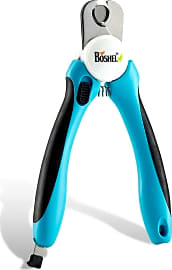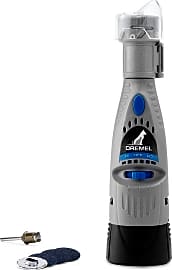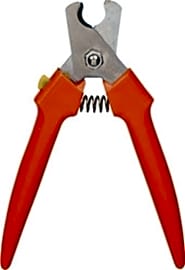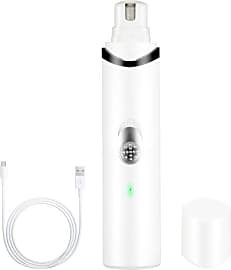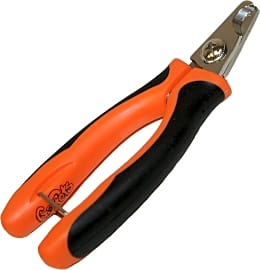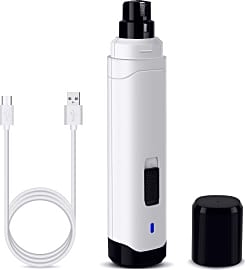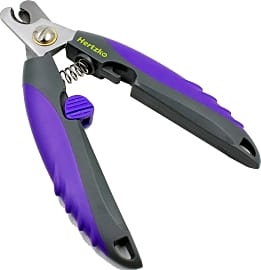The 10 Best Dog Nail Trimmers

This wiki has been updated 36 times since it was first published in September of 2016. Keeping your dogs’ nails trimmed benefits their health in many ways, by promoting proper posture, preventing discomfort, and ensuring correct joint alignment. Furthermore, consistent nail trims means pups are less likely to scratch their human friends or damage hardwood floors. The models on our list are designed to make the grooming process as easy and painless as possible. When users buy our independently chosen editorial choices, we may earn commissions to help fund the Wiki.
Editor's Notes
November 22, 2020:
Our list includes several options for those of you who don’t like using traditional trimmers. Though the Rucacio Grinder is a decent device, we replaced it with the similar, but better, URPower Grinder. Like the previous option, the latter has a diamond grinder and three ports sizes to accommodate different-sized breeds. However, it sports a smaller price tag, and has additional features, like a charge-indicator light and a quiet motor that’s less likely to scare anxious pets. The Casfuy Upgraded is another option that operates gently and quiet, helping to soothe puppy anxieties. Lastly, and perhaps the favorite among grinding trimmers, is the Dremel Grooming Kit. It holds battery power well and consistently gets the job done efficiently. However, it is fairly loud, so if you have a skittish dog, it may not be right for you.
If you have a small dog, check out the Safari Professional. As its name suggests, it is favored by professionals for its sharp, high-quality blades. The company specifies they work best for medium and small breeds. Along those lines, if you’re a groomer with small hands, the Resco Original Deluxe may be your pick. The small size of these guillotine-style clippers makes them an ideal fit for small-handed people.
If safety is your main concern, we included several options for you. The Hertzko HLN-18 features a safety guard to minimize the risk of cutting into the root of the nail, known as the quick. It also has a blade-locking feature, so you can store them safely in a home with children or unsuspecting adults. Additional child-proof options are the GoPets Trim Pliers and the Epica Pet, which both feature a similar locking mechanism that hides the blade. Unfortunately, the Boshel Clippers do not have a safe-storage lock, but their high-quality safety guard will prevent accidental injury to your fury loved one while in use.
December 19, 2019:
Clipping a dog's nails can be a hassle, but it's a necessary evil to keep them healthy unless they're constantly running over concrete and other terrains that can grind them down naturally. We know the task can seem quite daunting, and so we ensured there were multiple types of trimmers on this list to cater to varying approaches, whether you prefer a guillotine-type unit, an electric grinder, or traditional clippers. If you're worried about cutting the quick on accident, many of our selections come with helpful, thorough guides on how to safely trim nails and keep your dog calm at the same time. Some even explain how using baby oil can help you see the quick better.
When the Thunderpaws Safety became unavailable we took the opportunity to recommend the Shiny Pet Tiny in its stead. This option, as the name implies, is ideal for smaller pets, and can work on everything from a hamster and guinea pig to a kitten or puppy. They have oversized handles, but if you have very large hands, you might find them difficult to maneuver. We also added the Casfuy Upgraded at the expense of the Urpower Rechargeable, which is less reliable.
The Cutie Pet Supply Cutter was also plagued with deliverability concerns, and so we recommended the Millers Forge Quality in its place, a reliable tool at an economical price that has been lauded by professionals for a very long time. We also said goodbye to the Hertzko Electric to make way for the Rucacio Grinder, a superior, quiet option that holds a charge for a long time and accommodates small, medium, and large breeds.
Why It's Important To Trim A Dog's Nails
This is not only painful, but it also puts pressure on the toe joints.
Trimming a dog's nails is something most pet owners avoid, but it is actually essential to a dog's health. So, if you love your four-legged companion, you'll have to get comfortable tackling this important task. Either that or be willing to spend lots of money on a groomer every month.
When dogs live in the wild, their nails are naturally worn down as they travel across different terrain. Rocks and other hard surfaces act much like nail files for a dog. Domesticated dogs live very different lifestyles, though. They spend most of their time indoors or running on soft surfaces like your yard or dirt and grass at a dog park. Their nails don't encounter enough hard surfaces to naturally wear down, so you must cut them instead.
If left to their own devices, a dog's nails will quickly grow too long, which can lead to a number of health issues. Nails that are too long are more prone to breaking. Broken nails will often expose the quick – the soft inner cuticle of a dog's nail – which can be quite painful to a dog. An exposed quick also leaves a dog more vulnerable to infection.
When nails become too long, the can actually make simple acts like standing and walking painful for a dog. Long nails that are constantly pushing against the ground exert pressure back into the nail bed. This is not only painful, but it also puts pressure on the toe joints. This can lead to an unnatural gait and, over time, even completely change the alignment of the joints of the foreleg. As the joints of the foreleg become more and more realigned, it can make the foot look flattened and splay the toes, eventually resulting in a near permanent deformity. In other extreme cases, the nail has been known to completely curl under the foot, embedding itself in the dog's paw.
Nails also play a part in providing traction as a dog walks and runs. Excessively long nails, though, actually reduce traction and can cause a dog to slip when walking on hard surfaces. This can be especially problematic in older dogs who are more likely to seriously hurt themselves if they fall. If all of this wasn't enough to convince you that you need to trim your dog's nails regularly, just consider how much safer your legs and furniture will be .
Understanding The Two Main Types Of Doggy Nail Trimmers
Dog nail trimmers may come in a range of different styles, but they all fall into one of two main categories: clippers and grinders. Nail clippers have been around for considerably longer and are the go-to item of choice for veterinarians and groomers. Clippers can be further broken down into two sub-categories: guillotines and scissors.
Once properly positioned, you squeeze the handle and a blade moves forward to lop off the tip of the nail.
Guillotines feature a small hole in which you insert the dog's nail. Once properly positioned, you squeeze the handle and a blade moves forward to lop off the tip of the nail. Many people find it easier to cut through thick nails using a guillotine clipper, but it can be difficult to thread a dog's nail through, especially when dealing with an uncooperative pooch. Scissor trimmers look much like their name sake, though they will generally feature curved blades to better accommodate the shape of a dog's nails. Many people find scissor trimmers easier to use, as you can more clearly see exactly what you are cutting. You can also get scissor trimmers around a dog's nail quicker than guillotine models.
Grinders are basically small rotary tools that have been specifically designed for use on dogs. They gently sand a dog's nails down, while also rounding out the sharp edges for a smoother finish. Grinders are great for dog owners who fear using a clipper because of the possibility of cutting the quick. The downside is that many dogs are scared of the sound and sensation of the grinder at first, so it may take them some time to get used to it.
Getting Your Dog Used To Having His Nails Trimmed
The sooner you can expose your dog to the nail trimming process, the better. If you cut your dog's nails regularly when they are a puppy, it won't be a traumatic experience for them when they are older. Begin by getting your dog used to having his paws handled. It is pretty easy to integrate paw handling into your daily interactions. If you are carrying your dog around, hold onto one of his paws for a little while. When playing, periodically touch one of his paws in a manner that doesn't interrupt the game. When lying on the ground or couch together, gently hold onto or stoke one of his paws. Just make sure to touch different paws and not the same one all of the time. Progress to a point where your dog is comfortable having you hold onto his paw for an extended period of time and keeping his toes splayed.
Just make sure to touch different paws and not the same one all of the time.
Next, get your dog used to the trimmer. If using a grinder, this make take a little longer. Put a little peanut butter on the trimmer and let your dog lick it off. Once he is comfortable doing this, turn the grinder on and repeat the process. It goes without saying that you don't want to put peanut butter on the blade or grinder tip, but just in case: don't put peanut butter on the grinder tip or the blade.
Now that your dog is used to the trimmer and having his paws handled, get him used to having the trimmer touch his paws. Play a game where you touch the trimmer to your pup's paw and then give him a treat. Eventually he will be happy just to see the trimmer and more than willing to let it touch his paws.
When you first start actually trimming the nails, only do one nail per trimming sessions. After you have cut a single nail. Give your dog a treat and play a fun game with him. As your dog gets more comfortable with the clipping sensation, you can move onto cutting two nails per session, then three, and so on.



